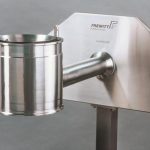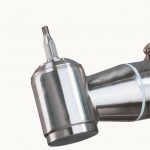Conical sieve mills are used in nearly every industrial application where dry powders are produced or processed. With the ConiWitt, Frewitt demonstrates the extent to which a mechanical base operation can be improved on a machine whose possibilities for innovation were thought to have been already exhausted. The simple, modular design of the ConiWitt is an outstanding feature that allows the unit to be easily built into existing facilities.
Today’s pharmaceutical industry uses mainly oscillating sieve mills. This type of mill is also widely used in the food proces-sing and chemicals sectors. Since the 1990s, however, an interesting alternative has been available in the form of the conical sieve mill. Conical sieve mills are especially suitable for disagglomeration. They operate according to a different principle and thus do not compete with oscillating sieve mills in any way. Neither the oscillating nor the conical sieve mill has been improved upon during the last ten years. With the launch of the ConiWitt, Frewitt has put an end to this technological stagnation in the conical sieve mill sector.
The rotor in a conical sieve mill turns within a conical sieve insert at speeds of 400 to more than 2000 rpm, depending on the application and the desired result. The sieve insert generally has an opening diameter of 0.5 to 1.0 mm. The total range of possible diameters extends from 150 µm to more than 5 mm. In addition to the frequently used round-hole and square-hole opening shapes, there are rasping versions of conical sieve inserts for use with hard or difficult-to-grind products. Two different rotor versions are available: the round rotor is used for dry products and the square rotor with a bevelled grinding side for moist substrates. Wet granules with poor flow properties or powders with a snow-like consistency can also be ground effort-lessly with the square rotor.
Large active surface
The process parameters of the ConiWitt have been improved to increase performance and facilitate a broader range of applications. The most significant enhancement is the enlarged active sieve surface area. The active surface of the ConiWitt-200 has been increased by 38 % compared to the former model. This larger active surface means a substantially higher output with the same milling chamber size. With the development of the ConiWitt, Frewitt has added a whole new dimension to classic cost engineering, in which production costs are at the forefront, by reducing the total costs of ownership. The result is a conical sieve mill that requires little time to set up. The ConiWitt is considerably easier to service when changing products or cleaning. Moving parts – the sieve and the rotor – are reduced to an absolute minimum. Misalignment of the sieve in the milling chamber is impossible thanks to the error-proof system. The ConiWitt-200 is the only conical sieve mill in which the slide ring seal can be changed with the rotor drive housing closed. Thanks to a shaft end seal installed under the slide ring seal for the life of the machine, service personnel do not come into contact with the FDA certified transmission fluid. The slide ring seal can be changed in fifteen minutes owing to this new, one-of-a kind conical sieve mill design.
Modular design
The ConiWitt mill is available in three different sizes: ConiWitt-150, ConiWitt-200 and ConiWitt-250. The number always refers to the infeed diameter (DN) according to the ISO standard. The milling heads of the smallest model, the ConiWitt-150, and the medium-sized ConiWitt-200 are interchangeable. The great advantage is that the same motor-arm construction can be used. Users of a ConiWitt-150 can thus adapt their mill to increased production simply by changing the milling head. In the same manner, in other words also by changing the milling head, users of the ConiWitt-200 can process batches in kilo laboratory sizes without having to purchase a new mill.
In the pharmaceutical industry especially, the autoclavability of the milling head (milling chamber plus rotor drive) is somewhat taken for granted – all the more so if the conical sieve mill is embedded in a larger installation. After the rotor and the sieve have been removed, the entire milling head is sterilised in an autoclave, usually together with the dismantled sieves and rotors. To do this, it is necessary to be able to remove the milling head from the shaft quickly and easily. The simplest way is with a tri-clamp connection like the one provided on the ConiWitt-200. The key factors for easy servicing are the weight of the milling head as well as the assurance that the head will stay on the mill after the tri-clamp connection is removed. The milling head weighed more than 24 kg on older models. The head of the ConiWitt-200 is a lightweight at a mere 22 kg.
Successful applications
A classic application of conical sieve mills in the pharmaceutical and fine chemicals industries is calibration of granules produced in fluid bed dryers. Prior to the fluid bed dryer step, conical sieve mills are also used for disagglomeration and grinding downstream of the high-shear mixer, which mixes powder components. A well-known manufacturer of fluid bed apparatus and high-shear mixers successfully employs the ConiWitt-200 both before and after the fluid bed dryer. The mill usually runs at low speeds of 400 to 600 rpm. A sieve with a minimum rotor-sieve clearance of 1.0 mm is used for calibration. This system allows 500 kg batches to be handled in less than 20 minutes.
A moist, explosive mixture is processed in the application upstream of the fluid bed dryer. A pressure surge-resistant version of the ConiWitt model is used for this purpose. Thanks to an accessory temperature sensor on the sieve and the rotor drive, this type is approved for use in Zone 20. This opens up entirely new possibilities for using this type of mill in other fields of application such as the chemicals industry, where processing takes place under extreme conditions. By virtue of a special option, ConiWitt mills can be simply swung out of the production flow, making it possible to change the sieve or the rotor as needed for products with different properties.
Hall 3.1, Booth K22
cpp 460
More information on the product
Bulk-Online
Achema 2006
Share:









